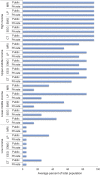Availability, accessibility, and affordability of neurodiagnostic tests in 37 countries
- PMID: 26446063
- PMCID: PMC4642148
- DOI: 10.1212/WNL.0000000000002090
Availability, accessibility, and affordability of neurodiagnostic tests in 37 countries
Abstract
Objective: To determine the availability, accessibility, and affordability of EEG, EMG, CSF analysis, head CT, and brain MRI for neurologic disorders across countries.
Methods: An online, 60-question survey was distributed to neurology practitioners in 2014 to assess the presence, wait time, and cost of each test in private and public health sectors. Data were stratified by World Bank country income group. Affordability was calculated with reference to the World Health Organization's definition of catastrophic health expenditure as health-related out-of-pocket expenditure of >40% of disposable household income, and assessment of providers' perceptions of affordability to the patient.
Results: Availability of EEG and EMG is correlated with higher World Bank income group (correlation coefficient 0.38, test for trend p = 0.046; 0.376, p = 0.043); CSF, CT, and MRI did not show statistically significant associations with income groups. Patients in public systems wait longer for neurodiagnostic tests, especially MRI, EEG, and urgent CT (p < 0.0001). The mean cost per test, across all tests, was lower in the public vs private sector (US $55.25 vs $214.62, p < 0.001). Each drop in World Bank income group is associated with a 29% decrease in the estimated share of the population who can afford a given test (95% confidence interval -33.4, 25.2; p < 0.001). In most low-income countries surveyed, only the top 10% or 20% of the population was able to afford tests below catastrophic levels. In surveyed lower-middle-income countries, >40% of the population, on average, could not afford neurodiagnostic tests.
Conclusions: Neurodiagnostic tests are least affordable in the lowest income settings. Closing this "diagnostic gap" for countries with the lowest incomes is essential.
© 2015 American Academy of Neurology.
Figures
References
-
- Atlas: country resources for neurological disorders [online]. Available at http://www.who.int/mental_health/neurology/neurogy_atlas_lr.pdf. Accessed September 25, 2015.
-
- Bower JH, Zenebe G. Neurologic services in the nations of Africa. Neurology 2005;64:412–415. - PubMed
-
- Hart JT. The inverse care law. Lancet 1971;1:405–412. - PubMed
-
- El Khamlichi A. African neurosurgery: current situation, priorities, and needs. Neurosurgery 2001;48:1344–1347. - PubMed
-
- Harttgen K, Vollmer S. Inequality Decomposition Without Income or Expenditure Data: Using an Asset Index to Simulate Household Income. Human Development Research Papers (2009 to Present) HDRP-2011-13, Human Development Report Office (HDRO), United Nations Development Programme (UNDP) [online]. Available at: http://hdr.undp.org/en/reports/global/hdr2011/papers/HDRP_2011_13.pdf. Accessed January 22, 2015.
Publication types
MeSH terms
LinkOut - more resources
Full Text Sources
Medical
Miscellaneous

